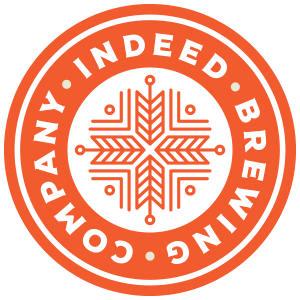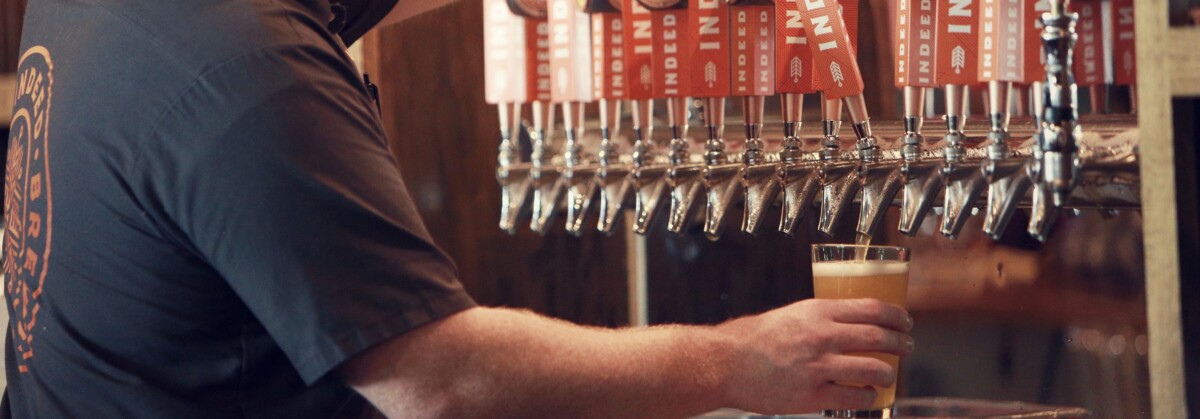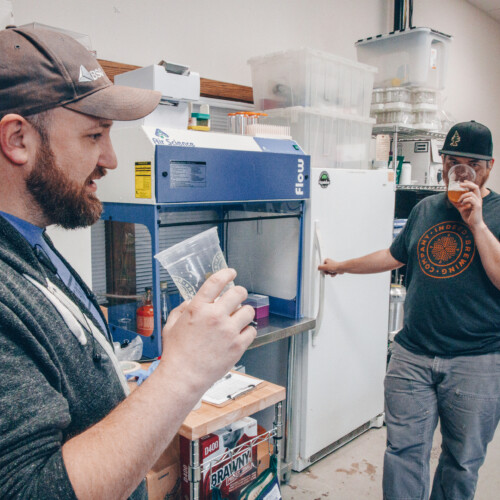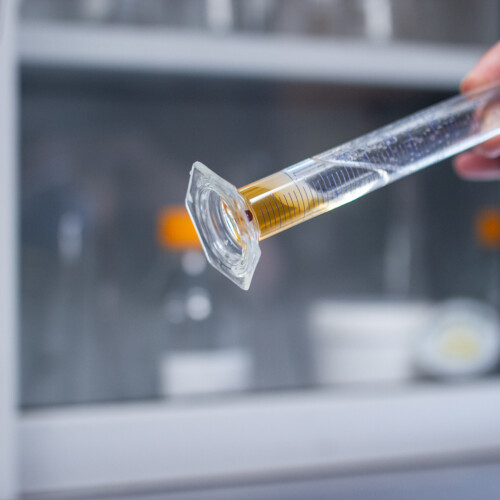Aug 12/20
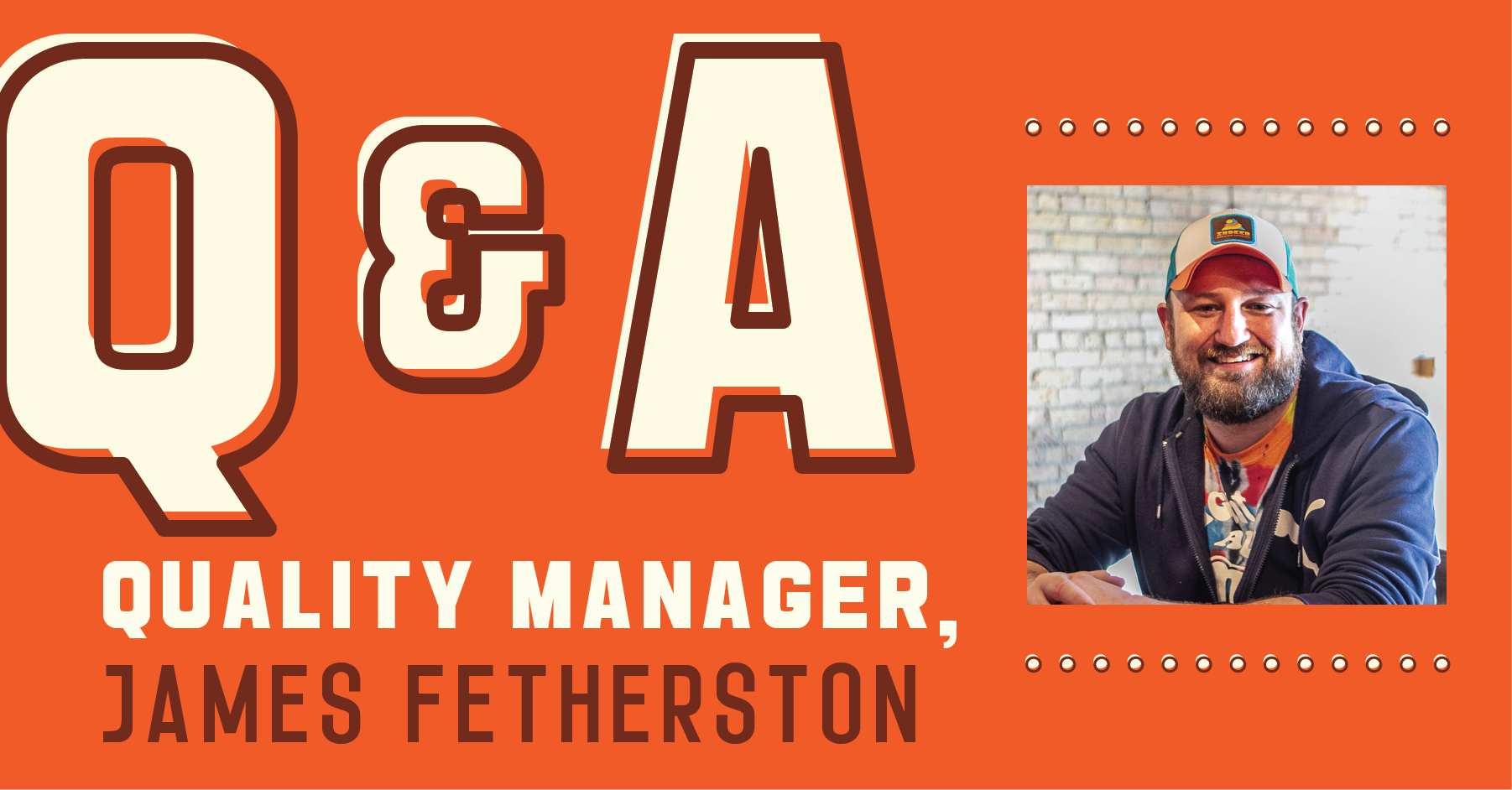
Good Beer, Guaranteed
Q&A with Quality Manager James Fetherston
Indeed has always promoted freshness in the marketplace by pulling past-code beer from store shelves and using easy-to-read date coding on its cans. And when bars and restaurants shut down in March, it was no question that Indeed would buy back kegs. But even before the beer is kegged or canned, Quality Manager James Fetherston makes sure it’s up to snuff.
What’s your background?
I went to UW-Oshkosh and have a degree in biology and psychology. After college, I got into a food lab, doing prep and worked my way up there to a senior microbiologist. For that time I worked in a lab down in Madison and transferred to the same company up here in 2008. So I did that for 4 years and then I was a production scientist at Beckman Coulter.
I got the job at Summit as the microbiologist and developed the program there. I did all the testing, detection, and the yeast management. I did that for 5 years and was tired of just doing micro so I actually brewed for a year and a half there.
I actually meant to brew for a few years, but the Quality Manager job at Indeed came up. I started in August 2019. This was one of the few jobs in town that I would take, that I would actually want to have. Just based on knowing Tom [owner] and a couple of people who work here, liking the beer, and having a nice, new shiny canning line. There’s not a lot of people with my background in town. It’s just a good fit.
What is quality control/quality assurance?
There’s a very scientific way to go about quality and there’s a practical way to go about quality. And we are kind of just getting out of the practical and into more of the scientific and lab-oriented side of things.
You start with QC, quality control. You always use QC, testing and whatnot. Quality assurance, QA, is more proactive. Over time, QC gets smaller and smaller and the QA starts to grow. Better process will create more consistent characteristics in your beer. Consistency— that’s where quality lies.
People conflate quality with flavor. I can’t tell you what to like. I can tell you what tastes good to me, but that’s all subjective. There are some beers that are a little more objective, like a pilsner. But what’s important for us is that our beer tastes the same way every time.
I don’t care what Pistachio Cream Ale tastes like as long as it tastes the same way over and over again, that’s what’s important to me. So I have to leave my biases at the door and work with what we as a brewery have decided this beer is going to taste like.
What’s your mission when it comes to quality?
For me, it’s mostly about respecting the consumer and making sure that if we’re releasing beer that we’re proud of it. That’s what drives us. We take it seriously here. Every good company that makes something respects the consumer and respects what they say. That’s something I learned at Summit. Quality’s part of that.
Can you drink beer after the expiration date?
There’s nothing in beer that will make you ill. There’s no pathogenic organisms, so the worst that will happen is it will make you wretch.
In terms of desired flavor, a highly hopped beer is not going to last more than 3 or 4 months, where we’re at. If you’re a bigger brewery, you might be able to do 6 months. A lot of it has to do with processes and clarifying your beer. If your beer can stay relatively stable with keeping your hops still pretty high, after 5 or 6 months, that’s impressive.
Day Tripper and Flavorwave are at 3 months but Mexican Honey Light could go 4 or 5. It's not as hoppy. There’s not as much in the malt bill, it’s just a little more straight forward. Not to say there isn’t a complex, nuanced flavor. You’re just not going to notice the loss of that malt complexity as much as when there’s hop flavor. Hops just kind of peter out and go away. And then you kind of have a ‘meh’ beer.
How can you tell if a beer is bad?
When you drink bad beer on the market, you’ll know it when you drink it. A lot of it has to do with age, if it doesn’t age well, or if it got warm. There’s heat flux that will bring out different characters in your beer. Off-flavors for heat are honey or sherry and loss of hop character. Old beer is like paper. It can be really papery and a little winey. But mostly, does it taste like butter or popcorn? That’s diacetyl.
When you look at a beer, what does the foam look like? Is it a nice foam? Is there no foam? What does the beer look like? Is it clear? Is it a little hazy? Is it full of shit? What’s the color? Is it gray or an amber or hay color. You smell it, what does it smell like? Is there anything?
I’m sensitive to DMS, which is a sulphur compound that gives off a cooked veggie character. If I smell that or taste that, I automatically go ‘nope, no thank you.’ There are breweries that do that purposefully in their beers, they want a little bit of DMS. Some English breweries want a little diacetyl. Is that wrong? I think contextually that matters.
The biggest thing for me is, does it feel like beer all the way through? Or does it turn into beery water? If you’re gonna take anything from how you taste a beer, it’s gotta finish and be beer all the way through. Homebrew often just dissipates into water and there’s no finish.
What is sensory training and why is it important?
Off-flavor training is great because you can start to learn about things that are bad in beer. But they’re not very common in beer. Most breweries are not having these issues. Starting to learn the vocabulary that goes along with tasting beer, instead of cherry picking bad flavors, that’s real sensory.
Before COVID, I was training Indeed staff to taste. I was getting everyone on board with the basic vocabulary—VATM (visual, aroma, taste, mouthfeel)—and starting to work in each category and start to parse things apart. As you grow that vocabulary, you can drink beer with more perception.
My first big trial is gonna be to get an extra month on Day Tripper, but you’ve gotta do a lot of sensory work. The problems with sensory are buy-in and time, getting people to come from wherever they are to do actually sensory trials. People being able to sit at a table and talk and being able to focus. That gets harder and harder to do with physical separation.
What’s your stance on dumping beer?
I have no problem dumping beer. And you have to have that mind-set or you’re not going to be a good brewer. It’s another basic quality measure. Yeah, there’s a lot of money that goes into it, but if you get it at the point where it’s only taking up the tank and you haven’t packaged it. It sucks, you lose money in raw materials, energy and some man hours. But canning it knowing that there’s something wrong with it and having to recall it, that’s a nightmare. Where I want to stop the buck is at the bright tank.
It’s an amateurish thing to put out bad beer or continue to put out bad beer. Because a) You didn’t know or b) You don’t care. And both of those have their own questions associated with them.
One of the reasons you came to Indeed was the new canning line. What’s special about it?
It’s a great piece of equipment. We have a couple guys who run it really well. If we didn’t have them, it wouldn’t work as well. It just wouldn’t. So it’s important to have well-trained people who care.
We can make beer a lot faster. It’s a 21-head rotary filler, most small breweries you’re gonna see a 4-head inline. We’re pretty small to have a filler like that. It’s nice that a company our size puts the kind of capital into that kind of equipment. We rode that thing all COVID, and it really helped us. Our off-premise sales did really well because we were able to put out all that beer all the time. We were meeting the demand.
There’s not a lot of time for air to get in there with this equipment. What it allows us to do is drive our DOs (dissolved oxygen) down really far. You can do that in well-maintained 4-head inlines as well, but it’s not to the same consistency or speed. There’s always gonna be oxygen in there, minute amounts, especially when you’re filling a vessel that’s not under pressure like a keg. The most important thing in the end is consistently low oxygen in our canned beer. The more oxygen, the faster it’s gonna stale the beer.
With a good filler you can drive both the DO and particularly the HSO (head space oxygen) down. And then you have less TPO (total package oxygen) in there to oxidize your beer over time. That’s one aspect of helping your shelf life of your beer, along with microbial stability and flavor stability. It’s one more tool in the tool box to help improve quality and keep your beer consistent.
So we have the nice filler, we have the machine to test it, and we also have all the seam check stuff to check it. I’m very confident in the product that comes off of that line. Every time we package, the beer’s going to be good. That is a nice piece of mind for me as a quality manager.
What’s your favorite beer?
I’m not gonna lie, I don’t really have a favorite beer. Our beer, other companies beers, I just don’t really have a favorite. The beer that I drink the most when it’s around is Let It Ride. Outside of that, Flavorwave. I usually try to drink whatever IPA we have.
